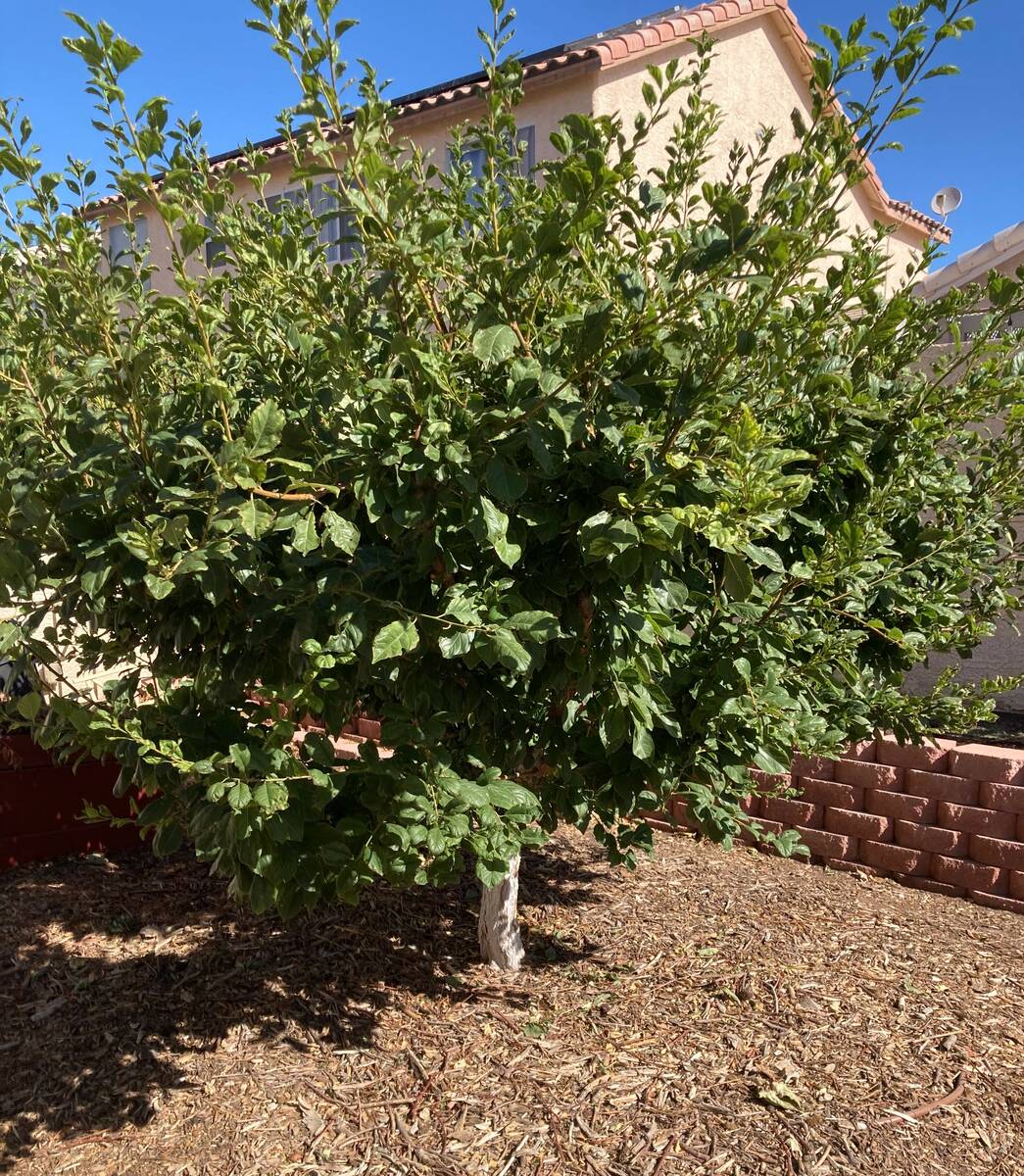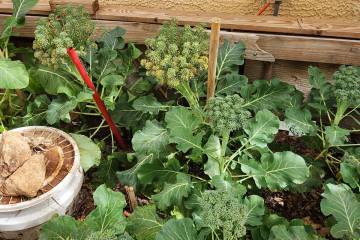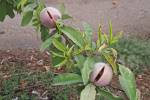Spots on pluot fruit probably nutritional problem
Q: I purchased a Flavor Supreme bare-root pluot tree at the University Orchard on Horse Drive in North Las Vegas six years ago. The pluots are plentiful and taste great. I spray the tree with horticultural oil in January, apply EDDHA iron around the tree in early spring and add a shovelful of homemade compost made from organic vegetable scraps, yard clippings and coffee grounds. The issue I had this year is some of the fruit had black spots on them and some have them inside the fruit as well. The leaves on the tree look good except for some wind damage which is expected. I looked online and the closest problem I can find is bacterial spot, but I would appreciate your expert opinion.
A: I doubt it is a disease problem. When growing fruit trees in the desert, I can count the disease problems with less than five fingers. Thank our low desert humidity for that.
Flavor Supreme pluot is an incredibly good variety, and it has produced fruit probably about three out of every five years when I had it at the University Orchard in North Las Vegas. It is not a heavy producer so that is probably why it has never been commercialized. I agree the fruit can be spectacular, but this particular variety can still be a light producer.
I never had black spots on the fruit before. It could be either from the sun (sunburn on the fruit) or, more likely, a nutritional problem. Sometimes a lack of calcium can cause nutritional problems that affect the fruit quality and has a similar look on apples (bitter pit) and pears (corky spot) growing in calcium-rich soils of the West.
I know it sounds strange, but calcium is mined quite heavily by some fruit trees in our calcium-rich soils. Try an application of compost other than what you are producing around the tree. Many composts are low in potassium as well but oftentimes high in nitrogen and phosphorus.
Try applying a granular fertilizer to the irrigated areas under the tree high in calcium, magnesium, sulfur and potassium early next spring. If that doesn’t work you may have to send a soil sample for testing to a certified agricultural soil testing lab (such as A and L in Modesto, California) or do it yourself but look specifically at the nutrient levels. It is probably not a pH (alkalinity) problem.
If it turns out to be a calcium deficiency, let me know and I can tell you we have corrected this problem. It may require spraying the leaves.
Q: The nursery told me that both ornamental trees I purchased were male Chinese pistache, therefore no berries. They were incorrect. As it turned out, this $1,000 tree was a female tree. It produced berries and I’m stuck with it. So, I cut off all the smaller branches that had berries completely level with the larger branch. Now, all the leaves are wilting, and some have brown and yellow spots on them. Another Chinese pistache planted within 10 feet of this tree, that I didn’t prune, is without any problems. I was wondering if I spread a disease like verticillium wilt with the pruning shears.
A: Some trees have male trees and female trees only. That’s how the sexes are separated in those trees. All the pistachio types are either male or female trees, similar to ash, African sumac and mulberry.
Verticillium wilt can be spread with unclean pruning shears, but this disease is usually soil born. I suppose if you dropped your pruning shears/loppers/saw on an infested soil you could pick it up and infect the tree, but I think that is a stretch.
I prune established pistache trees (nut trees) without any disease problems. I have done it many times, and the loppers and hand pruners were not disinfected prior to the pruning cuts. I don’t see that disease problem happening with that tree by pruning.
I would suspect, instead, sunburn of young limbs followed by borer problems early to midsummer. When pistache is young, it is rather a scraggly, open tree that fills in later.
If there is evidence of borer problems (bark lifting, sun damage to the upper sides of limbs, west or south exposures that are open to the sun), then apply borer control insecticides (they contain imidacloprid in the active ingredients) as a soil drench around the tree base, and see if the tree recovers over the next couple of years.
Q: I have a row of wax leaf privets I’m trying to irrigate. I used to use wood chips around these plants but was worried about choking them. Currently, I use two 4-gallons-per-hour drip emitters watering for one hour once a week. The tops are starting to die back and I’m wondering if it’s a watering problem.
A: Move woodchips and woodchip mulch away from the trunk 6 to 12 inches and no daily watering. Leave this area bare and open to dry out the soil and mulch. The particular disease you’re concerned about choking your plants is called collar rot or one of the so-called soil-borne diseases like Phytophthora.
Phytophthora collar rot or soil root rot will appear on many plants if soils are kept too wet. The heat just makes the problem worse.
If you are watering your plants daily, then the surface layer of woodchip mulch may not be an excellent choice for your plants. Whenever possible, try to avoid daily watering (except lawns, annual flowers or raised beds) when woodchip mulch is being used as it keeps the surface mulch of woodchips, and the soil beneath it, too wet. In some cases, daily sips of water may keep the soil too dry with difficulty managing the irrigation.
Q: We have four fruit trees (one orange, one lime and two types of lemon) in Sun City Summerlin. Shortly after they flower and begin to produce small fruit, the fruit falls off the tree. We don’t know if it is the result of the high winds, too much water or not enough water. Or maybe something else? We also fertilize regularly if that matters.
A: Fruit trees require fertilizer once or twice a year, that’s all — once as a half-application when they start to produce new growth and a second half-application after harvesting. The fertilizer is applied to the soil where the water is applied. If just fertilizing once, then a single early spring full application to the soil is enough.
All fruit trees produce more fruit as they get older. Some fruit trees don’t begin to set fruit after they are 6 to 8 years old, while others produce fruit earlier. Expect your fruit trees to produce more fruit as they get larger and older. Much of the timing of fruit production depends on the variety in the type of fruit tree.
Fruit dropping when they are young is quite common in all types of citrus. When trees are young, you see flowers with tiny fruit and then the fruit falls off the tree. It’s natural thinning that occurs on young trees and is normal. It helps the tree balance the demands of a fruit load.
Fruit drop can occur for lots of different reasons: lack of pollination, too much fruit on the tree, lack of water or too much, extremely high nitrogen fertilizer applications to name a few.
What is not normal is for fruit to drop from larger more mature trees when the tree has produced an abundance of fruit in previous years.
Q: Last year my rose bushes were prolific, and I didn’t have any problems. They already existed when I moved in two years ago and seemed to be thriving. I regularly spray them with Neem oil and Spinosad soap as per directed. This year, however, I have had myriad issues and have reached the point where I don’t know what to do. Do you have any suggestions to cure my plants?
A: Roses are excellent mesic shrubs for our area and perform very well. Our desert climate reduces disease problems on roses but not necessarily insect problems. The insect problems I have seen on roses here include aphids and ants, cane borer, flower thrips and a few others.
Many of these insect problems require a soil-applied hard pesticide. You might try a spring application of a Rose Insecticide that you can find at any of the box stores or nurseries. Some come combined with a rose fertilizer. Most of these are systemic with no need for reapplication for several months or none at all.
Bob Morris is a horticulture expert and professor emeritus of the University of Nevada, Las Vegas. Visit his blog at xtremehorticulture.blogspot.com. Send questions to Extremehort@aol.com.





























